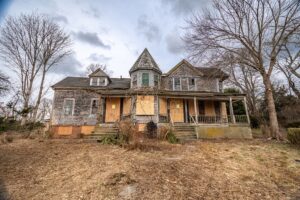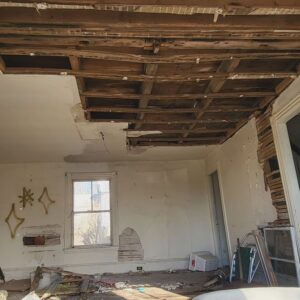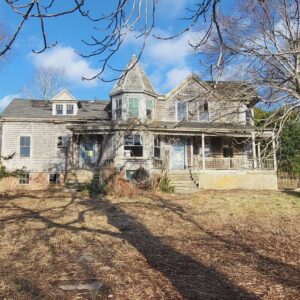WELLFLEET — A 19th-century Queen Anne-style house just off Route 6 once numbered among a cluster of grand properties owned by wealthy members of the local business community in a neighborhood called Money Hill.

But in more recent times, the house at 177 Peace Valley Road has fallen into disrepair and become a neighborhood nuisance, with broken windows and holes in the roof that have left the interior filled with rotting walls and unsafe floors strewn with debris and animal droppings.
The health department condemned the house in 2018, declaring it uninhabitable.
While it remains condemned, that may change because the state attorney general’s office, through an abandoned housing initiative, is now working with the town and property owner to get the site up to code.
Becoming a Blight
The house’s owner, Boston resident Robert Bonds, purchased the 3.7-acre property for $65,000 in 1983.

Helen Miranda Wilson, an artist and former select board member who lives next door, said his purchase marked the beginning of the house’s decline. Bonds never lived there himself. He rented it out, often to groups of young people on the Cape for the summer, Wilson said.
Big parties would keep Wilson and her late partner, Tim Woodman, awake until the early morning hours. “It was like living near a biker bar, with people puking in the bushes,” she said. “The building got more and more dilapidated.”
Wilson recalled one year when some artist friends were thinking of renting the house for the summer. “They came in March to look at it, and I went in with them,” she said. “It was really a wreck. There was a dead raccoon on the floor. My friend said, ‘This looks like a crack house.’ ”
Health department records show complaints dating back to 2001, when a neighbor reported that a heating oil tank lay in the bushes by the back door, a car battery was on the lawn along with other rubbish, and the two chimneys were losing so many bricks that one was nearly down to the roof line.
The health department sent Bonds a certified letter, giving him 30 days to address violations and threatening fines. The file contains no evidence that Bonds complied.
In 2011, a neighbor reported debris in the yard, electrical wires hanging from the trees, holes in the roof, and “no responsible person available.” The health agent contacted Bonds, who said he would send someone to start the cleanup. Again, the file contains no record of Bonds following through.
The next reference to problems was in August 2017, when then Health Agent Hillary Greenberg-Lemos wrote to Bonds saying an inspection was done based on a complaint. While officials could not go inside the house, Greenberg said it was obvious there were numerous violations of the state sanitary code.
A week after contacting Bonds, the health department received a letter from Cedar Freyss-Cole, who was living in the house and said he had an agreement with Bonds to take care of the grounds “and to maintain the integrity of the building until restoration can begin.” Plans for the work were underway, Freyss-Cole said, and would be brought in for review to the appropriate boards.
But based on the health department file, those plans never arrived. In January 2018, Greenberg-Lemos condemned the house as unfit for human habitation and ordered it secured. She contacted Freyss-Cole and told him he had to move out.
The police have also been involved. In November 2022, they contacted Bonds to say the front door was wide open, and the interior was exposed to the elements. At that point, Greenberg-Lemos contacted Town Counsel Greg Corbo, and by April 2023 the attorney general’s office was involved.
That wasn’t the end of the decay. Wellfleet Police Chief Kevin LaRocco said the police log shows that another broken window was reported this past October.
The Abandoned Housing Initiative
The attorney general’s Neighborhood Renewal Division, part of its Abandoned Housing Initiative, focuses on residential properties with severe code violations. Municipalities can refer properties to the division, which then works with the city or town to come to an agreement with the property owner on a plan to bring it back up to code.

If the property owner fails to comply, the division can ask the regional housing court to place the property in receivership. A court-appointed receiver then brings the property into compliance, making it safe to live in. According to the attorney general’s website, receivership also assures that property tax payments are up to date.
There has been progress on tax payments for 177 Peace Valley. The town’s treasurer, Jared Aponte, said Bonds has reduced a $30,777 delinquent tax bill to $5,120.
Of the 240 distressed properties now in the state program, 60 are in regional housing court with receivers being sought.
Under the program, the receiver pays for the cost of the repairs and then bills the property owner. If the property owner doesn’t pay, the receiver is given a lien on the property. The receiver can then petition the court to foreclose on its lien, and the property is then subject to a public auction or other court-approved method of sale.
In most cases, the receiver submits a bid on the property in the amount of the lien. If no other bid comes in higher, the receiver gets clean title to the property and can later sell it.
According to the attorney general’s office, 177 Peace Valley Road is not in receivership at this point.
The brush surrounding the house was recently cut back, and over the last couple of weeks, boards were placed over windows and doors, along with signs saying the house is uninhabitable.
Wellfleet’s current building inspector, Angelo Salamone, said he recently received a call from Assistant Attorney General Lizabeth Lagarto Marshall, who was checking to see if the town had issued a building permit for repair work on the Peace Valley house. Adrian Moylette of AMC Contracting in Norwell had filed a building permit application for $230,000 in repairs last April. The application was incomplete, said Salamone, so no permit was issued.
Following the call from Marshall, Salamone contacted Moylette, who secured all the doors and windows so that the property at least satisfies the minimum requirements for a condemned building.
“Now it’s in the hands of the health agent and the A.G.,” Salamone said.
Greenberg-Lemos is now Eastham’s director of health and environment; she did not respond to requests for comment.
Heith Martinez, Wellfleet’s new health agent, said he had not yet talked to the property owner, but he has spoken with Marshall. “The house is a hazard,” Martinez said. “It’s not safe to be in. It’s full of holes, and the wood is going to just break underneath you.”
Past Grandeur
The dilapidated structure is actually two 19th-century houses that were joined together. According to the town’s historic narrative on the property, James Swett, a local fish dealer, built a Cape-style house there in the 1850s. Swett passed the property to his daughter Sarah, who married Edmund Burke Collins, a member of the wealthy Collins Steamship family of Truro.
Collins moved a house by barge from Billingsgate Island and joined it to the existing house in the 1870s. He then added the Queen Anne elements — turrets, dormers, and porches.
Swett family descendants continued to own the property until 1946. It then passed through two owners, including a prominent Presbyterian minister who used it as a summer house, before being purchased by Bonds.
Bonds did not respond to a request for comment for this story, made through a nephew who is familiar with the Wellfleet property.



